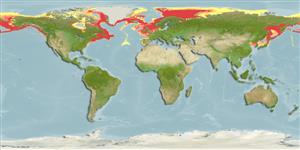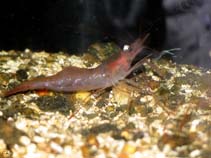Pandalus borealis Krøyer, 1838
Northern shrimp| Native range | All suitable habitat | Point map | Year 2050 |

|
| This map was computer-generated and has not yet been reviewed. |
| Pandalus borealis AquaMaps Data sources: GBIF OBIS |
Classification / Names প্রচলিত নাম সমূহ | প্রতিনাম সমূহ | CoL | ITIS | WoRMS
Malacostraca | Decapoda | Pandalidae
Environment: milieu / climate zone / গভীরতার পরিসীমা / distribution range বাস্তুসংস্থান
সমুদতলে ভাসমান বেনথোপেলাজিক; গভীরতার পরিসীমা 9 - 1450 m (সূত্র 85480), usually 50 - 500 m (সূত্র 85480). Boreal; -2°C - 12°C (সূত্র 85480), preferred 4°C (সূত্র 107945); 82°N - 35°N, 180°E - 180°E (সূত্র 85480)
Distribution দেশ সমূহ | এফ এ ও এলাকাসমূহ | বাস্তুতন্ত্র | দৃষ্টিগোচর | প্রচলন
Circumpolar. Temperate to polar.
Length at first maturity / আকৃতি / Weight / Age
পরিপক্কতা : Lm 2.4, range 2 - 2.443 cm Max length : 12.0 cm TL পুরুষ/ লিঙ্গ অনিধর্ারিত ; (সূত্র 8); 16.5 cm TL (female)
Short description বহিঃ অঙ্গ সংস্থান
Life cycle and mating behavior পরিপক্কতা | প্রজনন | ডিম ছাড়া | Eggs | ডিম্বধারন ক্ষমতা | Larvae
Main reference
সূত্র সংখ্যা | সমম্বয়কারী | সহযোগী
Piepenburg, D., N.V. Chernova, C.F. von Dorrien, J. Gutt, A.V. Neyelov, E. Rachor, L. Saldanha and M.K. Schmid 1996 Megabenthic communities in the waters around Svalbard. Polar Biol. 16:431-446. (সূত্র 2952)
IUCN Red List Status
(সূত্র 130435: Version 2025-1)
CITES status (সূত্র 108899)
CMS (সূত্র 116361)
Threat to humans
Human uses
মৎস্য: বাণিজ্যিক
FAO - মৎস্য: landings, species profile | FIRMS (Stock assessments) | FishSource | আমাদের চতুর্পাশ্বের সাগর
হাতিয়ার
আরো তথ্য
Max. ages / sizes
Length-weight rel.
Length-length rel.
Length-frequencies
Mass conversion
প্রাচুর্য
ইন্টারনেট সুত্র
BHL | BOLD Systems | CISTI | DiscoverLife | FAO(মৎস্য: species profile; publication : search) | Fishipedia | GenBank (genome, nucleotide) | GloBI | Gomexsi | Google Books | Google Scholar | Google | PubMed | জীবন বৃক্ষ | Wikipedia (Go, অনুসন্ধান ) | জুলজিকাল রেকর্ড



